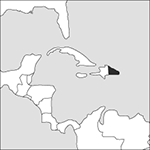
Source: MAPS IN MINUTES™ © RH Publications (1997)
Capital:
Santo Domingo
Area:
48,670 sq km (18,792 sq miles)
Population:
10,219,630 (2012 est)
Currency:
1 Dominican peso = 100 centavos
Religions:
Roman Catholic 95.0%
Ethnic Groups:
mixed 73.0%; White 16.0%; Black 11.0%
Languages:
Spanish (official)
International Organizations:
UN; OAS; Non-Aligned Movement; WTO
A country in the Caribbean, the eastern part of the island of Hispaniola.
Economy
Telecommunications, duty-free industrial zones, and tourism have been fostered and have now overtaken the formerly dominant agricultural sector, led by sugar, cocoa, bananas, coffee, and organic tropical fruit. Gold is the chief export, mostly from one of the world’s largest gold mines, which opened in 2012; silver and nickel are also important.
History
The island of Hispaniola was divided between France and Spain, with France gaining control of the entire island in 1795. Toussaint L’Ouverture took over the island soon after but the Spanish regained control of the eastern part of the island in 1809. The Dominican Republic declared its independence from Spain in 1821, although in the following year it was again annexed by Haiti. In 1843 the Dominicans revolted from Haitian domination, winning their second independence in 1844. Between 1861 and 1865 the Dominican Republic was re-annexed to Spain and fought a third war for independence (1865) under Buenaventura Báez. Anarchy, revolutions, and dictatorships followed, and by 1905 the country was bankrupt. The USA assumed fiscal control, but disorder continued and the country was occupied (1916–24) by US marines. A constitutional government was established (1924), but this was overthrown by Rafael Trujillo, whose military dictatorship lasted from 1930 to 1961. On his assassination, President Juan Bosch established (1962–63) a democratic government, until he was deposed by a military junta. Civil war and fear of a communist take-over brought renewed US intervention (1965), and a new constitution was introduced in 1966. Since then redemocratization has steadily advanced, the Partido Reformista being returned to power in the 1986 elections. The country occupies a strategic position on major sea routes leading from Europe and the USA to the Panama Canal. The Partido Reformista remained in power after the 1990 elections with Joaquín Balaguer as President. The latter resigned as party leader in 1991, but remained President. An IMF austerity programme in 1991 sharply reduced inflation and there were successful efforts to diversify the economy. In 1994 Balaguer was re-elected, but the result was contested. Fresh elections were promised and these resulted in the election as President of Leonel Fernández, leader of the centrist Partido de la Liberación (in 1996). He was defeated in 2000 by Hipólito Mejía, but was elected again in 2004 and 2008. Constitutionally forbidden to run for a third term, he supported the election of Danilo Medina in 2012. Medina was re-elected in 2016, instituted educational reforms and anti-corruption measures, improved the financial position of the country, and attempted to reduce illegal immigration from Haiti, the Republic's much poorer neighbour.
- polar climate
- polar compound
- polar concepts
- polar coordinates
- polar decomposition
- polar-desert soil
- polar diagram
- polar distance
- polar equation
- polar flattening
- polar form of a complex number
- polar front
- polar-front jet stream
- polar glacier
- polarimeter
- polarimetry
- Polaris
- polariscope
- polarity
- polarity chron
- polarity chronozone
- polarity epoch
- polarity event
- polarity excursion
- polarity interval